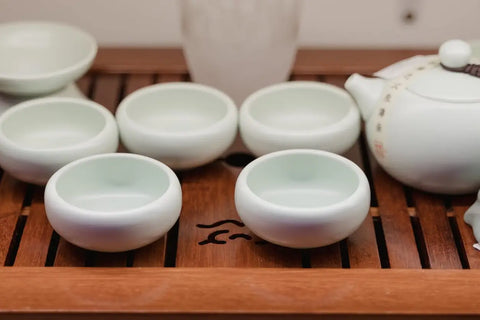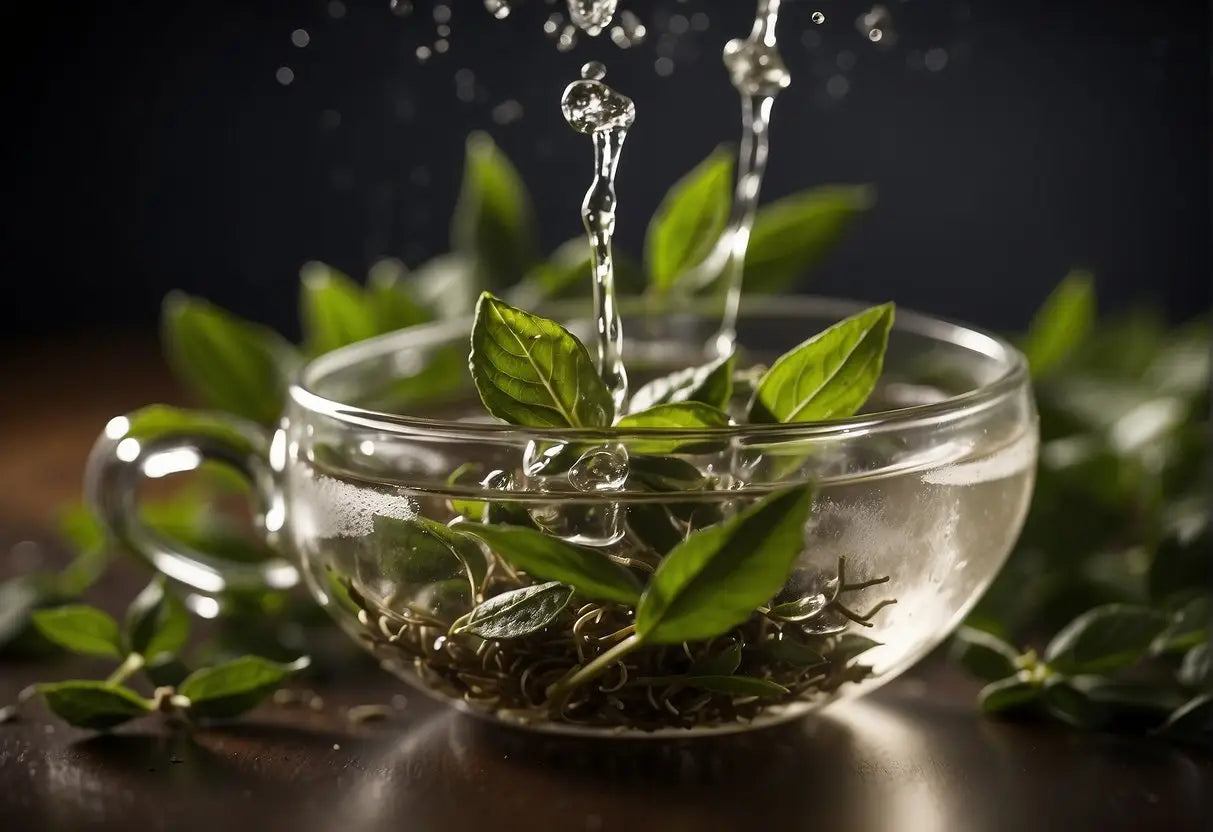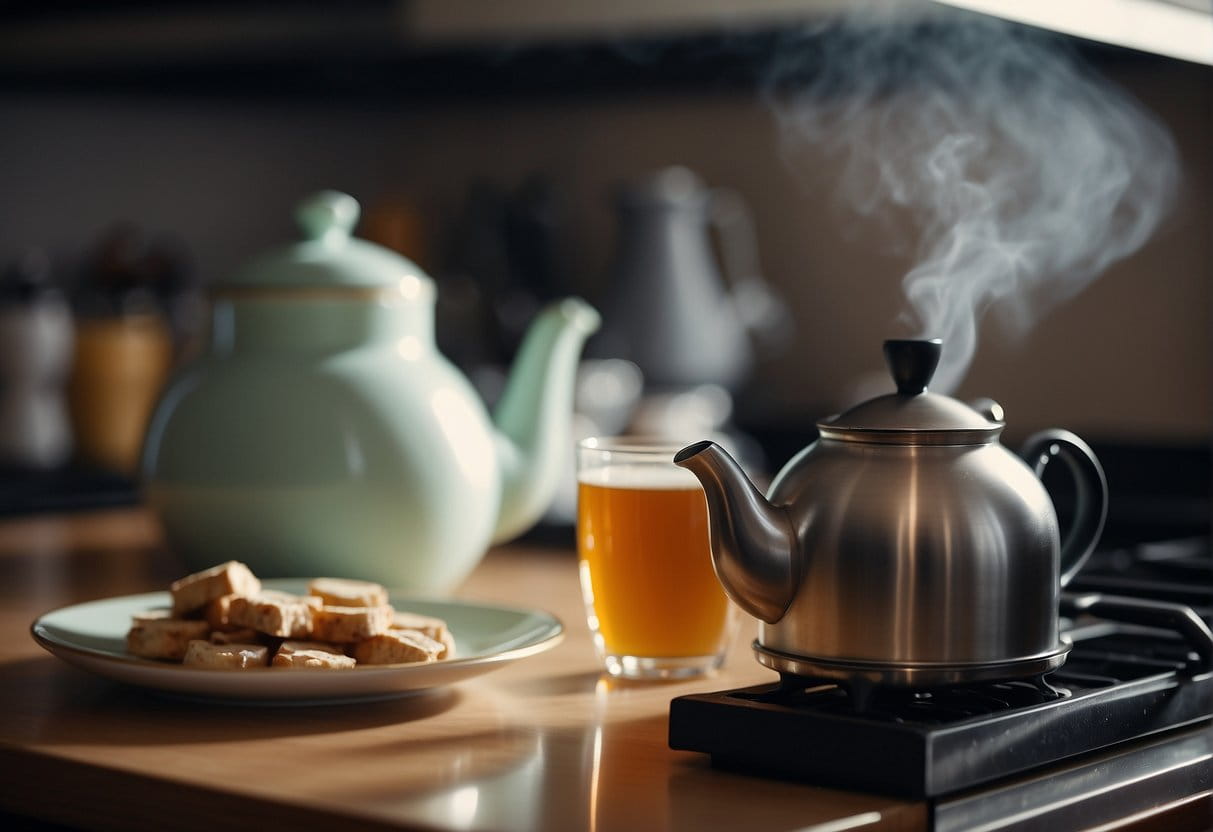How to Decaffeinate Tea
Decaffeination removes caffeine from tea leaves while striving to maintain their flavor and health benefits.
What Is Decaffeination?
Decaffeination is the process of removing caffeine from tea leaves. Caffeine is a natural stimulant found in various plants, including tea. Your objective in decaffeination is to lower caffeine content without significantly affecting the taste or health properties of the tea.

Bestsellers
Decaffeination Methods
There are several decaffeination methods, each with its own impact on the tea's flavor and chemical composition. These methods include:
- Water Process: Tea leaves are soaked in water to extract caffeine. The water is then treated to remove the caffeine and reapplied to the tea for flavor reabsorption.
- Carbon Dioxide (CO2) Process: High-pressure CO2 is used to selectively remove caffeine, preserving delicate flavors.
- Solvent-based Process: Chemicals like ethyl acetate or methylene chloride are used to extract caffeine, then are removed from the tea.
| Method | Solvent Used | Flavor Preservation | Chemical Residue |
|---|---|---|---|
| Water Process | Water | High | None |
| CO2 Process | Carbon Dioxide | Very High | None |
| Solvent-based | Ethyl Acetate/Methylene Chloride | Moderate | Minimal |
Effects on Tea Quality
The decaffeination process can affect the quality of tea in terms of flavor, color, and aroma. The challenge is to minimize these changes while effectively removing caffeine:
- Water and CO2 methods generally preserve more of the tea's original flavor and aroma.
- Solvent-based methods may alter the flavor more noticeably.
- The removal of caffeine may also reduce the bitterness, which some tea drinkers may prefer.
Certain decaffeination processes can also affect the antioxidant properties of tea, though modern techniques aim to preserve these as much as possible.
Preparation for Decaffeination

Before you begin the decaffeination of your tea, ensure that you have the following items:
- Fresh, cold water: The quality of your water affects the taste of your tea.
- Tea of choice: Any type of tea leaves can be decaffeinated, but fresher leaves may yield better results.
- Measuring spoons: To measure the amount of tea.
- A timer: Accurate timing is crucial in this process.
- A strainer or tea infuser: You’ll need this to separate the tea leaves from the water.
Follow these steps for preparation:
- Measure Your Tea: Use one teaspoon of loose tea or one tea bag for every six ounces of water.
- Heat Water: Bring your water to the appropriate temperature for your tea type. For example, around 212°F (100°C) for black tea and 185°F (85°C) for green tea.
- Pre-wet the Leaves: If using loose tea, rinse them by pouring hot water over the leaves and then immediately draining. This cleanses impurities and prepares the leaves for full flavor release.
Note: Decaffeination methods may slightly alter the flavor of your tea. Choose a preferred decaffeination method that preserves as much of the natural flavor as possible. Always follow recommended safety guidelines when handling hot water to prevent burns or injuries.
Decaffeinate Using Water Processing

To decaffeinate tea using water processing, begin by boiling water. Once boiled, pour the water over the tea leaves or tea bag in your cup or teapot. Allow the tea to steep briefly for about 30 seconds. This initial steeping releases most of the caffeine since caffeine is one of the first compounds that infuses into the water.
Next, discard this water, effectively removing a significant portion of the caffeine contained in the tea. Then, add more boiling water to the leaves or bag for a proper brew. Since water temperature and steeping times can vary by tea type, adhere to the following guidelines:
| Tea Type | Water Temperature | Steeping Time |
|---|---|---|
| Black Tea | 190-212°F (88-100°C) | 3-5 minutes |
| Green Tea | 175-185°F (80-85°C) | 2-3 minutes |
| Oolong Tea | 185-205°F (85-96°C) | 3-5 minutes |
| White Tea | 160-185°F (71-85°C) | 4-5 minutes |
Note: This method does not remove all caffeine but can significantly reduce its content.
Understand that repeated steeping may affect the flavor and aromatic quality of your tea. Therefore, this method can alter the tea's character, but it remains a non-chemical option to lower your caffeine intake. If you are extremely sensitive to caffeine or require a method that eliminates all caffeine, consider purchasing commercially decaffeinated tea, which is often treated using solvent-based processes.
Lao Ban Zhang
Decaffeinate Using Carbon Dioxide Method
The Carbon Dioxide (CO2) method is an effective way to decaffeinate tea while retaining its flavor. You take advantage of CO2's property as a solvent when under high pressure to selectively remove caffeine.
Step-by-Step Process:
-
Preparation:
- Moisten the tea leaves to open up their cellular structure. This step ensures that the caffeine is more accessible for extraction.
-
Pressurization:
- Place the moistened tea leaves into a pressure vessel.
- Introduce liquid CO2 into the vessel under high pressure. Pressures can reach up to 250 times atmospheric levels, which is critical for the CO2 to act as a solvent.
-
Caffeine Extraction:
- The CO2 bonds with the caffeine molecules due to its supercritical state, essentially dissolving the caffeine.
- The CO2 does not affect the other water-soluble components that give tea its flavor, resulting in a product that is nearly identical in taste to the original but without the caffeine.
-
Separation:
- Release the pressure to separate the caffeine-laden CO2 from the decaffeinated tea leaves.
- The CO2 is then passed through a charcoal filter, which traps the caffeine, allowing the CO2 to be recycled.
-
Finalization:
- Dry the tea leaves to remove any remaining moisture.
By using the CO2 method, you benefit from a solvent-free and chemical-free process. This technique ensures minimal flavor loss, making it preferred for high-quality teas.
Decaffeinate Using Organic Solvents

To decaffeinate tea using organic solvents, follow this process:
- Preparation: Start with loose-leaf tea or tea bags of your choice.
- Steaming: Gently steam the tea leaves to open their pores. This helps the solvent to penetrate the leaves.
Next, you will need to use an organic solvent. Common solvents include:
- Ethyl acetate: Often derived from fruits, it is labeled as "naturally decaffeinated".
- Methylene chloride: Effective, but less common due to its potential health concerns.
Procedure:
- Soak the steamed leaves in the solvent for a designated period, allowing the caffeine to dissolve.
- Careful Removal: Remove the solvent from the leaves, ensuring no residue remains.
Safety Tip: Always use food-grade solvents and adhere to proper handling guidelines.
Post-Treatment:
- Rinse the tea leaves thoroughly with clean water.
- Dry the leaves, either through air-drying or using a dehydrator.
Considerations: Decaffeination might affect the flavor profile of the tea. Always taste-test the tea after the process to check the flavor integrity.
| Organic Solvent | Usage Notes |
|---|---|
| Ethyl Acetate | Derived from fruits, milder flavor alteration, rinse thoroughly |
| Methylene Chloride | Effective decaffeination, use sparingly, ensure no residue left |
Final Steps: Store your decaffeinated tea in an airtight container to preserve its freshness and flavor.
Remember, this method requires precision and care to maintain the quality and safety of the tea.
Post-Decaffeination Processing
After the decaffeination of your tea, it's important to properly dry the tea leaves. Your objective is to minimize moisture content, which is essential to preserving the tea's quality and preventing mold growth. Use a food dehydrator or an oven at a low temperature (no higher than 200°F) and spread the leaves in a single layer on a baking sheet.
- Step 1: Place leaves on the drying tray or baking sheet.
- Step 2: Dry at low heat for 1-2 hours.
- Step 3: Check periodically for dryness. Leaves should feel crispy to the touch.
Once dried, promptly store the tea leaves in an airtight container to protect them from moisture and odors. Choose a container that blocks out light, such as tinted glass or a metal tin, and store it in a cool, dark place.
Use the following table to guide you in storing your tea:
| Storage Factor | Recommendation |
|---|---|
| Container | Airtight |
| Material | Tinted glass or metal |
| Location | Cool, dark place |
| Duration | Consume within one year for best flavor |
Lastly, if you notice any changes in color, smell, or flavor over time, discard the leaves to ensure you're enjoying your tea at its best quality. Remember, these steps are vital to maintain the tea's freshness and flavor profile after decaffeination.
Safety and Compliance Standards

When decaffeinating tea, it's imperative to adhere to strict safety and compliance standards to ensure the process is both effective and does not introduce contaminants.
Personal Protective Equipment (PPE):
- Gloves: Wear to protect your hands from direct contact with chemicals.
- Goggles: Use to safeguard your eyes from splashes.
- Aprons: Don to prevent chemical spills on clothing.
Chemical Handling:
- Certified Decaffeinating Agents: Only use agents approved by the Food and Drug Administration (FDA).
- Accurate Measurement: Employ precision scales for measuring chemicals to avoid excessive use.
Ventilation:
- Adequate Airflow: Ensure your workspace is well-ventilated to dissipate any fumes from the decaffeinating agents.
- Air Quality Monitors: Utilize to regularly check for the presence of harmful vapors.
Waste Disposal:
- Follow local regulations on the disposal of chemical waste.
- Labeling: Clearly label waste containers with the contents and hazard signs.
Quality Control:
- Testing: Regularly test decaffeinated tea to ensure it meets the maximum residual limits set by regulatory bodies.
- Documentation: Maintain detailed records of the decaffeination process, including quantities of chemicals used, and batch testing results.
Remember to consistently review and update your knowledge on the relevant safety protocols and compliance regulations, as these can evolve over time. Compliance with these guidelines ensures your safety and upholds the integrity of the decaffeination process.
Frequently Asked Questions

When looking into decaffeinating tea at home or understanding commercial processes, it’s important to consider safety, methods used, and the availability of naturally decaffeinated products. Here, you will find concise responses to common queries on this topic.
What are the safest methods for decaffeinating tea at home?
You can safely decaffeinate tea at home by steeping the tea leaves in hot water for a short period, discarding the water, and then steeping the leaves again. This removes most of the caffeine while preserving the flavor of the tea.
Which chemicals are commonly used in the commercial decaffeination of tea?
Commercial decaffeination of tea often involves the use of ethyl acetate or carbon dioxide. These solvents selectively remove caffeine while maintaining the integrity of the tea's flavor compounds.
Are there any health risks associated with drinking decaffeinated tea?
For most people, decaffeinated tea is considered safe and does not pose significant health risks. However, those with sensitivities to chemical residues should opt for teas decaffeinated using water or carbon dioxide methods to avoid potential traces of chemical solvents.
How do major tea brands, like Twinings and Lipton, decaffeinate their tea?
Major tea brands, such as Twinings and Lipton, typically use methods like ethyl acetate decaffeination, carbon dioxide decaffeination, or water processing to remove caffeine from their teas. Each brand may specify their method on product packaging.
Can you recommend any naturally decaffeinated tea brands that are available?
Some brands offer naturally decaffeinated tea options, such as Celestial Seasonings' herbal varieties or Rooibos teas, which are naturally caffeine-free without undergoing a decaffeination process.
What is the best organic decaf black tea on the market?
For organic decaf black tea, the Stash Tea Company offers a high-quality option that is decaffeinated using a natural carbon dioxide process, which ensures minimal processing chemical residues and a robust flavor.
← Older post Newer post →











